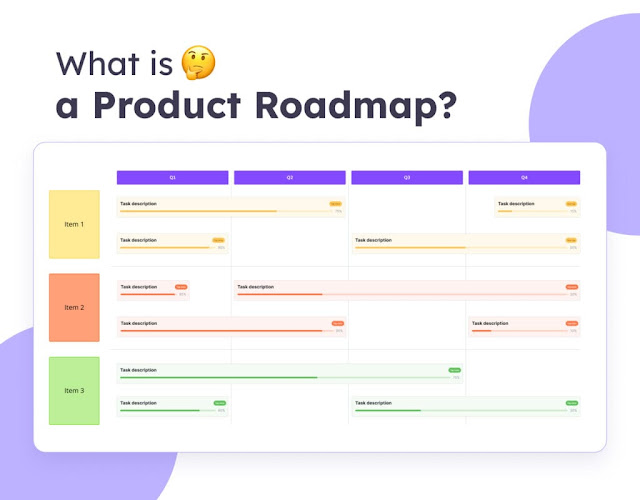10 Must-Have Features for Product Roadmap Template
Introduction:
A well-structured Product Roadmap Template is crucial for product management. It aligns teams, sets clear goals, and ensures timely delivery. This template helps visualize the product journey, from inception to launch and beyond. Unlike a project roadmap, which focuses on specific projects and their timelines, a product roadmap emphasizes the product's lifecycle, including feature development, market positioning, and customer feedback integration. Here are ten must-have features that are discussed below:
1. Clear Objectives and Goals
Every product roadmap should start with clear objectives and goals. These elements define the purpose of the product, target market, and desired outcomes. Including this feature ensures everyone understands the product's direction and purpose.
2. Timeline and Milestones
A detailed timeline with milestones is essential. This feature helps track progress and ensures timely completion of tasks. It allows teams to see what needs to be done and when. Milestones act as checkpoints, keeping the project on track and allowing for adjustments when necessary.
Related Article: https://masterplanmanagement.blogspot.com/2024/07/Project%20Schedule%20Template.html
3. Feature Prioritization
Not all features are created equal. A Product Roadmap Template should include a method for prioritizing features based on customer needs, market demand, and business value. This ensures the most critical features are developed first, providing maximum value to users.
4. Stakeholder Involvement
Involving stakeholders in the roadmap creation process is vital. This feature allows for feedback and ensures the product meets the needs of all involved parties. It fosters collaboration and keeps everyone aligned with the product vision.
5. Resource Allocation
Effective resource allocation is crucial for the successful execution of a product roadmap. This feature helps manage resources, including budget, personnel, and tools. It ensures the team has what it needs to achieve its goals without overextending.
Related Article: https://masterplanmanagement.blogspot.com/2024/07/HR%20Management%20Templates_0950363777.html
6. Risk Management
Every product development process faces risks. Including a risk management feature in this template helps identify potential risks early and plan for mitigation strategies. This proactive approach minimizes disruptions and keeps the project on track.
7. Customer Feedback Integration
Customer feedback plays a critical role in product development. This template should include mechanisms for collecting and integrating customer feedback. This ensures the product evolves based on real user needs and experiences.
8. Competitive Analysis
Understanding the competitive landscape is essential. This feature involves analyzing competitors' products, market strategies, and positioning. It helps identify gaps in the market and opportunities for differentiation.
9. Progress Tracking
Tracking progress is necessary to ensure the product development stays on course. This feature involves setting key performance indicators (KPIs) and tracking them regularly. It provides insights into the team's performance and highlights areas needing improvement.
10. Communication Plan
A robust communication plan is vital for keeping all team members and stakeholders informed. This feature outlines how updates will be shared, ensuring transparency and keeping everyone on the same page.
Related Article: https://masterplanmanagement.blogspot.com/2024/07/Project%20Dashboard%20Template.html
Importance of a Product Roadmap Template:
This template is more than a planning tool. It aligns the entire team with the product vision and strategy. By outlining objectives, timelines, and resources, it provides a clear path for development. It also helps in prioritizing tasks, ensuring the most valuable features are developed first. Stakeholder involvement and customer feedback integration ensure the product meets market needs and expectations. Risk management and competitive analysis features provide a proactive approach to potential challenges, making the product more resilient.
Difference Between Project and Product Roadmap:
While a Product Roadmap Template focuses on the overall lifecycle of a product, a project roadmap is concerned with specific project timelines and deliverables. The product roadmap outlines long-term goals and strategic initiatives, including feature development, market positioning, and customer feedback. In contrast, the project roadmap details the steps needed to complete a particular project, including tasks, deadlines, and resource allocation.
Related Article: https://masterplanmanagement.blogspot.com/2024/07/Work%20Plan%20Template.html
A product roadmap is a strategic document that guides the product's evolution. It looks at the bigger picture, encompassing various projects and initiatives contributing to the product's success. It considers market trends, competitive landscape, and customer needs, providing a comprehensive view of the product's future.
On the other hand, a project roadmap is more tactical. It focuses on executing specific tasks within a set timeframe. It deals with the here and now, ensuring that the current project progresses smoothly and meets its deadlines. It does not necessarily consider long-term strategic goals or market positioning.
Related Article: https://en.wikipedia.org/wiki/Product_strategy
Conclusion:
In summary, this template is essential for any product development team.
#Product Roadmap #Roadmap Templates #Project
Management #Management Templates #Excel Templates #Strategic Templates
#Roadmap #Dynamic Dashboard #Powerful Templates #Excel
.jpg)



Comments
Post a Comment